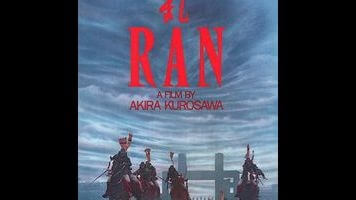One nightmarish battle sequence, all by itself, justifies rushing out to any theater in your vicinity showing the 4K restoration of Ran, Akira Kurosawa’s 1985 riff on King Lear (as well as similar Japanese legends). Actually, “battle sequence” dignifies what happens—it’s more of a prolonged slaughter, as the Lear figure, Lord Hidetora Ichimonji (the great Tatsuya Nakadai), sits motionless in a burning castle while everyone around him is riddled with bullets and arrows. Two women stab each other simultaneously, to avoid a worse fate, while a third carefully positions a large knife on the floor, pointing upward, and bends over it before the film discreetly cuts away (to more carnage). The screams of the dying would be agonizing to endure, except that Kurosawa, having eschewed music for the preceding hour, suddenly cranks up a keening orchestral score by avant-garde composer Tôru Takemitsu—the only thing heard for several minutes, until one particular gunshot abruptly and jarringly restores diagetic sound. The sequence works on TV, but is truly soul-shattering when experienced on the big screen, in all its intended awful grandeur.
The rest of the film isn’t too shabby, either. Unlike Kurosawa’s Throne Of Blood (1957), which sticks fairly close to Macbeth, Ran only vaguely resembles its Shakespearean source; the director claimed he was well into the planning stage before realizing the similarity, at which point he deliberately incorporated it. Most notably, Lord Hidetora has three sons rather than three daughters, and the nature of his folly, which plunges the realm into internecine warfare (the Japanese title translates as Chaos), is quite different. There’s no contest to see which child loves Dad best—Hidetora simply announces his plan to relinquish power, which he confers entirely to his eldest son, Taro (Akira Terao). Middle son Jiro (Jinpachi Nezu) takes this in stride, but youngest son Saburo (Daisuke Ryû), who’s no meek Cordelia, tells his father that he’s an idiot if he believes his offspring to be any less ruthless and destructive than he himself has been. Hidetora promptly banishes Saburo from the kingdom, only to discover that his other two sons have little interest in hosting him and the 30-man retinue he retains. As in Lear, the situation gets ugly in a hurry.
“As flies to wanton boys are we to th’ gods,” says Gloucester in Lear. “They kill us for their sport.” (For ludicrously in-depth analysis of that line, see Kenneth Lonergan’s Margaret.) Ran paints a much less arbitrary portrait of human suffering. While Saburo is kind of an asshole—disrespectful and abusive, whereas Cordelia merely declines to join her sisters in ass-kissing insincerity—he correctly recognizes that Hidetora maintained power via cruelty, and that giving up power is an invitation to be treated cruelly in turn. Reflecting that bleak philosophy, the film’s most memorable supporting character is Taro’s wife, Lady Kaede (Mieko Harada), whose entire family was butchered by Hidetora years earlier and who sees an opportunity to avenge them. Her machinations, horrific as they are, feel justified to some degree, undercutting the angry cries to the gods made by Kyoami the fool (played by an actor who goes only by Peter). It’s a truly pitiless vision, arguably even bleaker than Lear’s… and that’s saying something.
At the same time, Ran represents the color/widescreen zenith (qualification necessary due to Seven Samurai) of Kurosawa’s genius for spectacle. Each of Hidetora’s sons is color-coded—Taro is yellow, Jiro is red, Saburo is blue—and every frame looks uncommonly vivid, creating tension even during moments of stillness. There are also remarkably few close-ups for such a dialogue-heavy drama, with most scenes playing out in carefully composed masters judiciously intercut with alternate angles (shot simultaneously, it seems; the match cuts are perfect), the latter usually still having been shot at some distance from the actors. This 4K restoration, which had its premiere at last year’s Cannes Film Festival, marks the first time in decades that the film will be seen properly by a wide audience; currently available Blu-ray editions are disappointingly soft and muddy-looking, apparently sourced from inferior elements. A new and improved home-video transfer is tentatively scheduled for May, for those who don’t live near one of the cities where Rialto’s theatrical re-release will be traveling. But this is one of the year’s major cinematic events. It’s well worth leaving the house for, should that opportunity arise.


 Keep scrolling for more great stories from A.V. Club.
Keep scrolling for more great stories from A.V. Club.